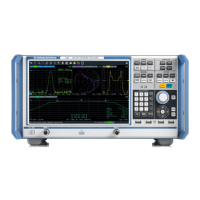GUI Reference
R&S
®
ZNB/ZNBT
321User Manual 1173.9163.02 ─ 53
The required number of points depends on:
●
the frequency span Δf = f
stop
– f
start
(see "Start Frequency / Stop Frequency / Center
Frequency / Span Frequency" on page 385),
●
the stop distance d
stop
(see "Start Distance / Stop Distance" on page 320), and
●
the velocity factor v of the transmission line (see "Cable Type..." on page 321).
With c
0
denoting the speed of light in a vacuum, the analyzer sets the number of
sweep points N to
N = max { ⌈ 2.6 · d
stop
· Δf / (v · c
0
) ⌉ , 201}
If the required number of sweep points would be higher than 100001 (the maximum
number of sweep points of the R&S ZNB/ZNBT), the analyzer sets N to 100001 and
displays the following message box:
"OK" reduces the frequency span Δf to
Δf = v · c
0
· 100001 / (2.6 · d
stop
), which makes 100001 sweep points sufficient for
unambiguous display (see the formula above). However, this reduction of the fre-
quency span comes at the cost of coarser distance resolution.
"Cancel" (default) leaves the frequency unchanged.
Remote command:
CALCulate<Chn>:TRANsform:DTFault:POINts
Cable Type...
Opens a dialog that allows to select a preconfigured cable type to be used for the cal-
culation of the Distance to Fault traces on the active channel. A cable type is defined
by its relative permittivity (or its velocity factor), and a frequency-dependent attenuation
table.
Select "Available Cable Types..." to access the list of predefined and user-defined
cable types (see Chapter 6.5.7.2, "Available Cable Types... Dialog", on page 323).
Remote command:
CALCulate<Chn>:TRANsform:DTFault:SELect
Trace Config Softtool

